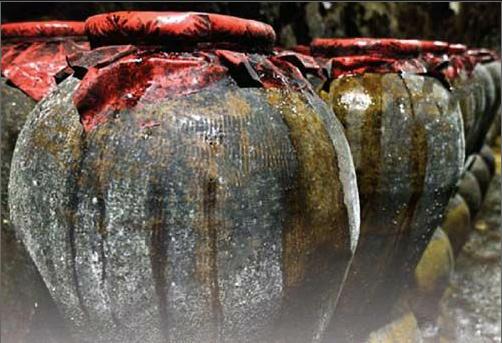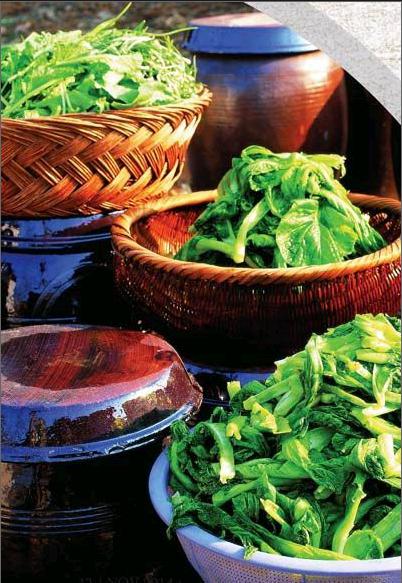Chemical Mystery Of The Traditional Cuisine
Ruan+Guangfeng



A Bit of China, a very popular documentary, show us various traditional Chinese foods since ancient times, such as the fresh bean curd, appetizing pickle, fragrant and sweet liquor, delicate preserved meat, and many others. Traditional gourmet leave fragrance in the mouth so that people talk about its delicacy frequently after eating over thousands of years. Simple and common, these dishes imply miraculous chemical mystery.
Tofu - The Production Technology
Bean curd has always been popular among the people, such as stewed beancurd with minced pork in pepper sauce, dried bean curd, bean curd mixed with chopped green onion, and others, all of them are frequent dishes for us. Beancurd is delicious but hard to make, but this is interesting too. What is the theory of making beancurd by magnesium chloride? What happens during the process?
When bitten or gypsum is put into soybean milk, its positive ion and negative ion will combine with hydrone of beancurd milk, which will break the combination of protein and water, making particle of protein come together and form sediment. And then separate protein particles will get together and turn into white beancurd jelly; then squeeze the water, thus beancurd jelly become bean curd. Tofu and beancurd jelly are soy protein which is agglomerate.
Fermented Glutinous Rice - Fermentation
Fermented glutinous rice has a long history, however, it has another name in ancient times. According to Word and Expression, there was a man whose name is Yi Di, he is a producer of liquor, Yu enjoyed his wine and began to alienate him. Wine with dregs mentioned in the book might be something similar to it.
The making of fermented glutinous rice is to mix Chinese yeast with sticky cooked rice and then it is made after fermentation. It has different names in parts of China, such as rice wine, grains and others. While Chinese yeast is called distillers yeast whose main element is microorganism for fermentation, including germ and fungus, acting as making sticky rice fermented.
What will happen during the process of fermentation for the fermented glutinous rice? The main ingredient of sticky rice is starch(one of polysaccharide), with amylopectin as the main element. After casting Chinese yeast on it, and it contains many fermentatioin microorganism, first rhizopus and yeast begins to reproduce and secretes amylase, which turn starch in the sticky rice into hydrolyzing glucose, thus we get the sweet taste of fermented glutinous rice. Then, a layer of white mycoderm, actually speaking it is hypha of rhizopus, will grow in the surface of fermented glutinous rice. After that glucose undergoes glucolysis metabolism inside the fungus in an oxygen-free atmosphere, decoposing glucose into ethyl alcohol and carbon dioxide, thus, fermented glutinous rice has a taste similar to liquor and it is basically made.
The fermentation time of it needs to be paid much attention: if it takes too much time, flavor of liquor will be too strong and taste bad; if with inadequate time, then the rice will not be good enough, like sticky rice. In addition, youd better not open the lid when fermenting where needs less oxygen, and other germ in the air might enter into the container and contaminate infectious microbe.
Pickles - Pickling
In Sichun province, a southwestern province in China, the one who excel at making pickles can be called an expert with pickling hands. While in northeast China, before the approaching of winter, people also make pickles called “ a dish welcoming the coming of spring” in snowy areas. In the previous time, vegetables in improper season were not popular like nowadays, and people would suffer from cold winter lack of vegetables without the skill of making pickles ahead of the coldness. Pickles has been a national identity in Republic of Korea, and Koreans made Kimchi its name. The making of the pickles is to take some fresh vegetables, such as cabbage, pepper and other vegetables, and put them into pickle jar with dried surface, then add water and salt , one thing needs to be mentioned, do not put too many vegetables into the jar. If you like, you can place some condiment like Chinese prickly ash on the vegetables, then seal with jar lid, next, put some water on the rim of the jar, in the end, put it into a shady and cool place. But what on earth will happen to the pickles in the jar?
Seen from the outside, the pickle jar remains quiet. But in the jar, large quantity of microorganism have already become active caused by lactic acid bacteria, and fermentation is expected to be performed in the jar, so it is regarded as one of the oldest biochemical reactor. Lactobacillus decomposes sugar of the vegetables into fermenting and lead to lactic acid, that is why pickles taste acid, while the flavor of crisp and tender is also caused by lactic acid bacteria. The truth is, it lacks of protease which can decompose protein , so it was unable to digest bioplasm in the cell of plant tissue, it can only take advantage of soluble matter, such as sugar feefused from vegetables and amino acid , acting as the source of breeding and activity. In this way, pickle tissue can remain straight and crisp and develop a special flavor.
What is more, during the making of pickles, because of the accumulation of lactic acid, the value of Ph in the pickle juice can be reduced to below 4, such acid atmosphere will limit the activity and breeding of decayed bacteria that can decompose protein and butyrate that can produce bad flavor, which serves as preventing infectious microbe and the production of bad flavor. Many people prefer to put some condiment like Chinese prickly ash in the salted water where vegetables were put, which not only can season the vegetables, but can sterilize, fight against antiseptic and resist oxidation. However, we have to pay much attention to hygiene conditions during the making of such vegetables so that it will not cause them go bad by contamination.
Bacon - Dring and seasoning the meat in the smoke of fire
As a Chinese saying goes:” it is time to pickle fish and duch when the seventhe and eighth day of the twelfth lunar month”. People in many areas in China begin to prepare for pickling meat when approaching the twelfth lunar month every year. The traditional making of the bacon is to add auxiliary food materials like salt, qu liquor, condiments to fresh meat, then bake or put it under the sun and in the smoke on the fire. The meat is with special flavor, strong fragrance of dried meat, can be kept for a certain long time. What on earth will happen when drying it in the sun ? what bring such huge change to the fresh and smoothy meat?
Making dried meat depends on such process like pickling, smoking and baking, which can add inviting flavor and appearance to the meat. Firstly, baking (drying in the sun) and adding more salt can reduce water activity in the dried meat, in this way, most germ and saccharmycetes are unable to survive in such water activity and it will not go bad drying in the air. Moreover, maillard reaction between amino acid and revertose can be caused by baking and baking can lead to degradation of fat, producing much fragrant volatile substance. This is the reason why pickled meat become so tasty.
Smoking is also an important step. When smoking, woods will release flavor component, such as phenols, acids, alcohol, aldehydes and others. Acids can lower the value of Ph of meat, increase inhibiting effect of salt to microlbial, accelerate nitrite reaction, strengthen pickled effect. What is more, the meeting of wood smell and meat can improve its flavor, on the one hand, smoke together with part of heat can make the meat itself release fragrance; on the other hand, through diffusion, permeating and absorption, the volatile constituent in the smoke will be absorbed into the meat, producing smoky flavor. Phenols in the smoke have a strong ability to oxidation resistance and can prevent fat oxidation, control the growth of microbial, make it convenient to keep.

